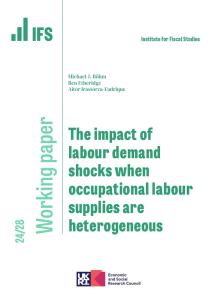Minimum wages can play an important role in raising living standards, and have become an important part of a government’s toolkit in addressing low pay. In the forthcoming election, both main parties have commited to increasing the level of the minimum wage. This briefing note sets out some background behind these proposals.
Key findings
- Labour and the Conservatives both plan to take the minimum wage to a historical high and give the UK one of the highest minimum wages among developed countries.
- The Conservatives have pledged to raise the National Living Wage (NLW) to two-thirds of median hourly wages by 2024 and extend it to 21- to 24-year-olds. This is around 7% higher than expected under current policy for those aged 25 and over and 16% higher for 21- to 24-year-olds.
- Labour plans to introduce a £10 minimum wage in 2020 for all employees aged 16 and over. This represents a 17% increase on current plans for those aged 25 and over and a 26% increase for 21- to 24-year-olds. It would increase minimum wages for 18- to 20-year-olds by 58% and for 16- and 17-year-olds by 123%.
- Around 1.9 million employees aged 21 and over (8%) are paid at or below the minimum wage in 2019, set to increase to around 2.3 million (9%) in 2020 under current policy. Under the Conservatives’ plans, the number of employees directly affected would double to 4.3 million – about one-in-six employees – by 2024. Under Labour, it would treble to 6.5 million – or one-in-four employees – by 2020.
- Women, part-time workers and those in the North of England and Wales would be most affected. Among employees aged 21 and over, a third of women, nearly half of part-time workers and around 30% of those in Wales and the North would be directly affected by Labour’s £10 minimum wage. More than half of all employees aged 21 and over in the hospitality sector would have their wages effectively set by the government under the Conservatives’ plans, and nearly two-thirds under Labour.
- The Conservatives’ plans would see the share of 21- to 24-year-old employees directly affected by the minimum wage rise from 9% today to 36% by 2024. Under Labour policy, 49% of 21- to 24-year-old employees, 82% of employed 18- to 20-year-old employees and 94% of 16- and 17-year-old employees would be directly affected by the minimum wage.
- The direct benefits from minimum-wage increases would mostly go to middle- and higher-income households. Only 22% of minimum-wage workers today live in the lowest-income fifth of working households, and only 19% live in a household that is in relative poverty. Many of those who live in low-income households will see part of their gains from higher wages clawed back through reduced entitlements to means-tested benefits such as universal credit.
- There is clearly a good case for further increases in the minimum wage if the aim is to help the low-paid. The evidence suggests that minimum-wage rises so far have substantially boosted earnings, and there is little evidence of negative effects on employment or hours of work. This includes early studies of the post-2015 National Living Wage, though the evidence on that is more tentative at this stage.
- But caution is still required when going about further rises. Previous evidence is of very limited use when assessing the likely impacts of large additional increases. Both parties’ plans would take us well into uncharted waters for the UK, while Labour’s plans would take us beyond where any similar economy has gone. Beyond some (unknown) point, a sufficiently high minimum wage must reduce employment. We need to tread carefully to boost the wages of the low-paid without damaging employment prospects too severely.
- A concern with both parties’ proposals, then, is not the scale of ambition but the implied process for trying to get there. Both parties are moving away from the previous model, based on evidence-based recommendations from an independent commission. Labour’s plans in particular would leave no time to respond if it turns out that the appropriate minimum wage is somewhere between its current level and £10 per hour, since the evidence on any negative employment effects would take time to come in and yet the minimum would have been raised to £10 in one fell swoop. If parties engage in a bidding war over minimum wages, they may end up hurting the very people they hope to benefit.











